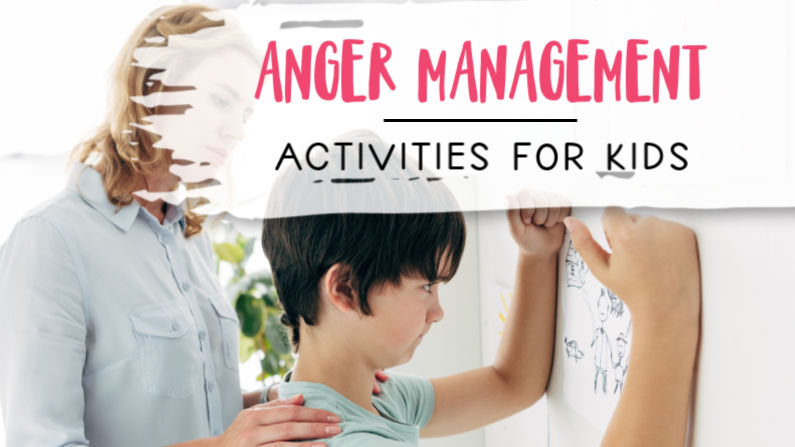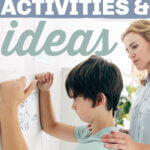Anger management activities for kids can be really helpful in teaching children to calm down and control their anger. There are many fun activities, games, skills, and projects that you can use with angry kids.
This post may contain affiliate links.
Helping Your Child Understand Anger
If you have an angry child, one of the first and most important steps for them is to understand their anger. It is very important for children to understand that anger, in and of itself, is just an emotion. Anger is not an identity, a cause for punishment, or an uncontrollable force.
In fact, anger can be a very helpful emotion. Anger can alert us that something is wrong, that there is a problem that needs to be solved.
Often kids who struggle with managing anger wind up facing a lot of shame and blame. Both from themselves as well as from their parents, teachers, and even friends. Most angry kids are used to hearing statements like, “why can’t you just be good.” Or, “can’t you just control yourself and stop yelling?”
These types of comments and attitudes can be very harming. They can teach children that they are bad because of their anger. The underlying shame in these types of approaches can cause a child to spiral further into self-loathing and eventually give up on even trying to “be good.”
Most parents never intend to harm their child with shame or blame. The problem is that parenting or teaching a child who has angry outbursts and defiant behavior can feel maddening and out of control.
How to Help an Angry Child
Once you and your child have understood that anger is just an emotion, the question becomes, how can you help an angry child.
Depending on the child’s behaviors, you may have different goals for them such as:
- Controlling their angry outbursts at home
- Learning to use words instead of physical violence
- Following directions and commands without arguing or falling into a tantrum
- Reducing angry behaviors such as yelling and being destructive
The good news is that there are so many great anger management activities for kids and tools that can help angry children. Whether you are working on helping a child learn to use words to communicate their emotions or find ways to stop throwing so many tantrums, these tools can help most angry kids! These activities are for aggressive children, kids who struggle with rage, and for the child who just needs to learn a few coping skills to calm their anger in the moment.
Calm Down Tools
Teaching children skills that will help them calm down can be very useful. You can also utilize tools and spaces to encourage calm down behaviors such as a Calm Down Corner, Calming Kit, or Coping Skills Cards.
Identify Triggers
Another important way to help children start to manage and control anger is to help them identify their anger triggers. There are many great kid-friendly ways to teach and work on anger triggers.
One of my favorite anger trigger exercises for kids is to provide them with a comprehensive list of potential triggers such as getting in trouble at school, feeling tired, having someone touch their belongings, etc. Having a checklist like this can be really helpful as many kids that I work with have a difficult time coming up with ideas on the fly.
The Brave Guide to Anger printable workbook has an anger triggers list for kids as well as other anger management activities for kids to put their anger triggers into categories so that they can begin to recognize what triggers really set them off as opposed to just annoy them.
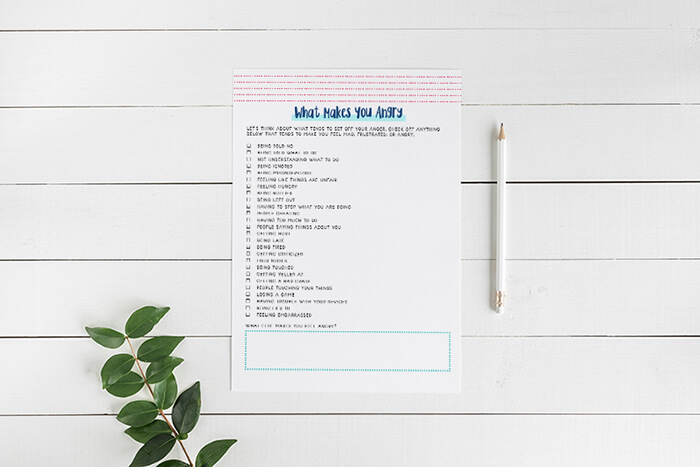
Learn the Signs of Anger
Another important step in working with a child on managing their anger is to help them understand what anger feels like in their body. Make a list of personal symptoms or signs of anger such as a red face, clenched fists, raised voice, and/or a racing heart, etc.
You can also use the idea of an Anger Thermometer to identify what symptoms your child starts to have when they are just a little annoyed, what signs they feel when they are getting mad, and what their body does when they explode in anger.
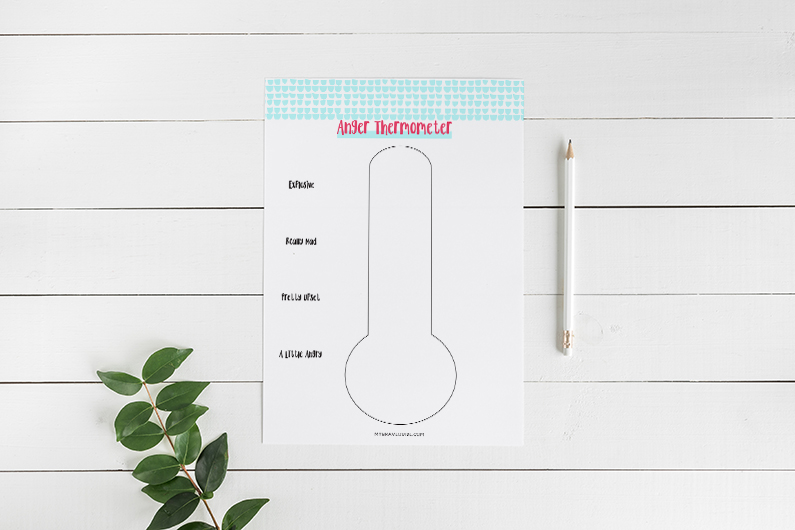
Anger Management Activities
If you are looking for fun and helpful activities to use with your angry child, there are many different approaches to anger activities that will work.
Coping Skills Activities for Calming Anger
There are many great anger management activities for kids in the “coping skills” category that can really help kids learn to control and calm their anger. The great thing about kids learning these skills is that they will transfer to any emotion or behavior that they need to work on.
Deep Breathing: Kids often really like doing deep breathing exercises. This category of coping skills is great for helping kids learn to calm down. Deep Breathing is also a great activity to pair with anger trigger/anger signs work.
Distraction: Distraction is another really useful coping skill. In this category, you can use activities such as a 5 Senses Scavenger Hunt or an ABC Scavenger Hunt. Teaching kids to distract themselves when they are angry can be a great way to bring calm back into a tense situation!
Exercise: Often times kids who struggle with anger have a lot of pent up energy. Using physical exercise to help channel that energy into appropriate outlets can really help to reduce angry behaviors. Activities that involve clenching muscles and relaxing, jumping, or bending overall have positive effects on angry kids.
Anger Worksheets
Worksheets can be a really helpful tool in therapy or classroom settings. They provide a concrete and neutral place for a child to get their thoughts and feelings out.
Anger Iceberg: The anger iceberg is a great analogy that is easy for kids to work on and understand. I have a fun copy of this included in The Brave Guide to Anger or you can simply draw an iceberg shape with the waterline. Have kids list what is going on “under the surface” of their anger including thoughts, feelings, and worries.
In my Control/Out of My Control: This is a great anger management activity for kids who get mad about being out of control. Start by thinking of a situation that made the child mad. Have the child trace their hand (or simply draw a circle). Inside of the hand write things that were in their control about this situation. Then, have them write what was out of their control in the situation outside of the hand. Explain that we can choose how to handle things that are within our control and we can choose to let go of worries and anger over things that are outside of our control.
Positive Affirmations: Working on positive affirmations can be another really great way to address anger. Affirmations work really well at targeting and shaping thoughts and feelings. For a fun worksheet that guides kids through the process of creating their own positive affirmations, check out this DIY Positive Affirmation Poster Kit.
Anger Management Games
Addressing anger in group or counseling settings can pose the opportunity to teach through play. According to FamilyLIves.org,
“Play is one of the main ways in which children learn and develop. It helps to build self worth by giving a child a sense of his or her own abilities and to feel good about themselves”
-Family Lives
Anger Weather Reporters: This is a great game that can help children learn to recognize what anger feels like as well as name their anger triggers. Have children create a weather report either by writing, drawing, or speaking. Their weather report will detail what emotions are taking place inside.
So instead of saying that it is partly cloudy with a chance of rain in the afternoon, a child could report that they are feeling hot and their mind is spinning and that their may be an explosion that involves yelling and name calling if things continue to heat up.
Jumping Tape Game: This is a fun anger management game that can be done at home, in a counseling office, or in a classroom. You can either have a piece of tape or some other marker already placed on the wall and then have the child try to jump up and reach the tape 10 times. Or, give the child 3-5 pieces of tape and have them jump up placing the tape as high as they can and try to get it higher each time.
The act of jumping helps to refocus energy when a child is feeling triggered. Jumping will also get the heartrate up which will help breathing become deeper and more beneficial which leads to mood stabilizing feelings.
The Angry Beach Ball Game: This is a great group counseling or classroom activity to help children practice coping skills for anger management. Prior to the game get a beach ball that has multiple colored sections. In each section write the following:
- Show us your favorite method of deep breathing
- Start us off with a round of 5 Senses Scavenger Hunt
- Name one thing you can do to calm down when you are angry
- Tell us about a time when you calmed yourself down and didn’t explode in anger
- Lead us in 10 Belly Breaths
- Tell us about one of your anger warning signs
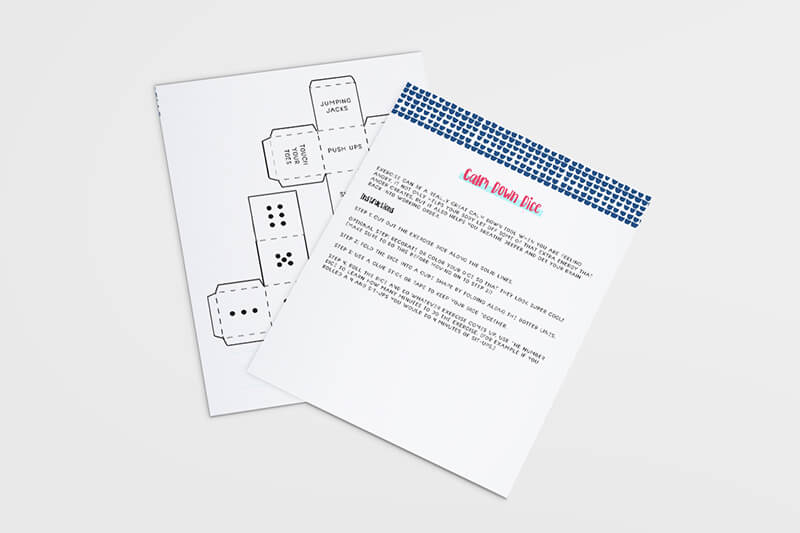
Calm Down Dice: Calm down dice are a really fun way to get kids to expel extra energy and anger. This fun little activity can be purchased individually or it also comes in the Brave Guide to Anger.
Marble/Straw Breathing: This is a great anger management game that can be done in a group setting or one on one. (I also have this activity in my calm down kit at home!)
You will need a straw and a marble for each person playing. Have the angry child blow the marble from one point to another (across a table or across the room). Focusing their breath through the straw helps to reset their breathing patterns and calms down angry feelings and behaviors.
Anger Craft Project
Using art or crafts to understand, calm, and control anger is another great method of teaching kids how to manage their anger. Some kids really enjoy being creative and are better able to learn through creative projects.
Stress Balloon: Create a Stress Ball with 2 simple ingredients. You will need 1 balloon and a jar of playdough. Have the child roll playdough into smaller portions. Hold the balloon open with both hands and place playdough inside of the balloon. The stress ball is a great tool to use in a calm down kit!
Stress Slime: Kids love making slime. The tactile feel of playing with the finished project can be very calming for some kids.
Straw Painting: Straw painting can be a great representation and conversation starter for discussing anger. Give each child a piece of paper, a straw, and some watered-down tempera paint. Have the child place a drop of paint on the paper and then blow it with a straw. This will create an “explosion” of paint. You can use this to talk about what sets off the child’s anger. Or, you can turn the explosions into anger monsters and have the kids describe what anger looks and feels like inside of them.
Emotions Charades: Kids who struggle with anger often have a hard time understanding, vocalizing, and recognizing other emotions. The more skills that they can gain in recognizing and expressing emotions, the better they will become at controlling their anger.
To play emotions charades, write down different emotions on slips of paper and have kids take turns acting out the emotion while other kids guess. This is a great classroom game that kids really love to play.
The Best Anger Management Activities for Kids
There are really so many different ways to work on anger management with kids. It is helpful to keep the concept of play in mind as this can really help to neutralize topics and allow kids to learn.
The goal of teaching children to manage their anger will be to help them understand what anger looks and feels like for them, what sets them off (anger triggers), and how they can calm down and avoid getting angry in the first place. Using anger management activities for kids is one of the best ways to help kids learn to manage their angry behaviors.
